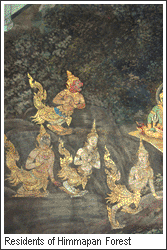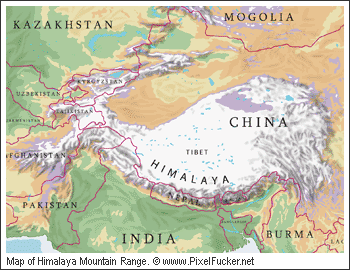
If you have ever visited Asian countries such as Thailand or India, you may find some similarities in their art and architecture. If you look closely into these arts and crafts, you will see many strange animals decorating the scenes. Most of them are what can be described as a "combined-animal" as for example, a horse with a bird's head, a man with lion body, etc. These animals are actually mythical creatures who dwell in the legendary Himmapan Forest. The forest is said to be located in the Himalaya Mountains. (The word "Himalaya" in ancient Sanskrit means "abode of snow". Perhaps that's also how the name "Himmapan" was derived.) It is also believed that the forests are located below the Buddhist heavens and are invisible to the eyes of mortals, who can never approach or enter.The mountain are found on the Chomputaweep (India) sub-continent and cover 3,000 square yods (1 yod equals to 10 miles or approximately 16 kilometers). The base circumference is measured at 9,000 yods. The mountain system has 84,000 peaks containing 7 large ponds (Anodard, Gunnamunta, Rottagara, Chuttanna, Gunala, Muntakinee, and Srihuppata). Anodard pond's is surrounded with 5 peaks which are considered to be the great peaks of Himmapan. Each peak is 200 yods in height, 50 yods in width, and 50 yods in length.
 There are many types of creatures living in the forest. Most of the creatures here are very different from what we have in our physical world. In fact, these animals are believed to be from artists' imaginations derived from ancient manuscripts describing how they look. Hence, you may see totally different looking creatures with the
There are many types of creatures living in the forest. Most of the creatures here are very different from what we have in our physical world. In fact, these animals are believed to be from artists' imaginations derived from ancient manuscripts describing how they look. Hence, you may see totally different looking creatures with thesame name. That is perhaps due to different intepretations of the artists.
Where in Physical World is Himmapan Forest?
Himalaya is a mountain system in Asia, comprising a series of parallel and converging ranges and forming the highest mountain region in the world. More than 30 peaks of the Himalayas rise to heights of 7,620 m (25,000 ft) or more, and one of these, Mount Everest (8,848 m or 29,029 ft), is the world’s highest mountain.
The average width of the Himalaya is about 200 kilometers. The range runs east to west up to central Nepal and then takes a southeast to northwest direction. The Hindu Kush-Himalaya mountain chain extends over 3,500 km in multiple countries of Afghanistan, Pakistan, China, India, Nepal, Bhutan, Bangladesh and Myanmar (Burma). The climate in Himalayas is quite unpredictable. The Himalayan Alpine climate varies according to the elevation. It gets colder as the elevation increases and gets wetter as the elevation drops.

How we classify Himmapan creatures?
Mr. Chueng Slaylanon wrote a book titled “Thai Art” (1951 AD) in which he categorized Himmapan creatures into 3 categories: two-legged creatures, four-legged creatures, and fish-based creatures. This categorization method has since been a standard for grouping Himmapan creatures.
However, we feel that grouping the creatures by the real animal on which they are based is a much more relevant method and also allows a reader to more easily recognize and understand each creature based on their common similarities.
The following 15 categories have been used throughout this website to group the Himmapan creatures.
+ Ghilen based Creatures
- Chinese Ghilen
- Thai Ghilen
- Winged Ghilen
+ Deer based Creatures
- Mareet
- Panorn Maruek
- Upsorn Sriha
+ Lion based Creatures
- Buntu Rajasri
- Kala Sriha
- Kraisorn Rajasri
- Tinna Sriha
- Gaysorn Singha
- Hemaraj
- Kochasri
- Kraisorn Jumlang
- Kraisorn Karwee
- Kraisorn Naga
- Kraisorn Puksa
- Loto
- Payak Kraisorn
- Sang Prang
- Sagoon Kraisorn
- Sinkh
- Singha Karwee
- Singha Khak Kar
- Singha Panorn
- Singto Jean
- Srihara Mungkorn
- Thep Norasri
- Tichakorn Jatubod
- To
- To Thep Singkha Nat
- Tukka Tor
+ Horse based Creatures
- Durong Kraisorn
- Durong Puksin
- Hemara Ussadorn
- Ma
- Ma Peek
- Ng-eye Sai
- Sinta Pakunchorn
- Sinta Pa Nattee
- To Thep Ussadorn
- Ussadorn Hayra
- Ussadorn Vihok
+ Rhino based Creatures
+ Elephant based Creatures
- Erawan
- Karin Puksa
- Waree Kunchorn
- White Elephant
+ Cattle based Creatures
- Mungkorn Vihok
- Torapee / Torapa
+ Monkey based Creatures
- Gabil Puksa
- Mucha Nu
+ Canine based Creatures
+ Bird based Creatures
- Asoon Puksa
- Asura Wayupuk
- Gai (Cock)
- Nok Garawake
- Garuda
- Hongsa
- Hong Jean
- Kocha Puksa
- Mayura Khon Tun
- Mayura Wane Tai
- Mungkorn Sagunee
- Nak Puksee
- Nak Puksin
- Nok Hussadee
- Nok Insee
- Nok Thet
- Payak Wane Tai
- Nok Sadayu
- Suea Peek
- Sagoon Hayra
- Sintu Puksee
- Sriha Subun
- Subun Hayra
- Nok Sumpatee
- Thep Kinna Norn
- Thep Kinnaree
- Thep Puksee
- Nok Tuntima
+ Fish based Creatures
- Hema Warin
- Kunchorn Waree
- Mucha Naga
- Mucha Wan
- Nang Ng-uek
- Pla Kwai
- Pla Seau
- Saringka Mussaya
+ Crocodile based Creatures
- Gumpee Nimitr
- Hayra
+ Crab based Creatures
+ Naga based Creatures
+ Human based Creatures
- Khon Tun
- Makalee Pon



